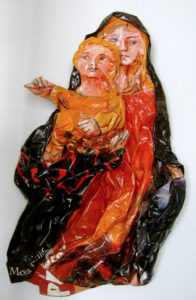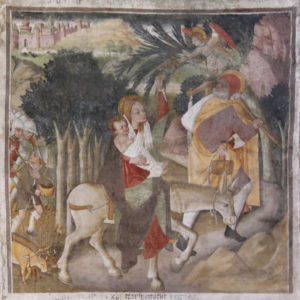 Madonna con Bambino (Madonna with Child)
Madonna con Bambino (Madonna with Child)
Véronique Champollion
2008
Paper (posters), glue, fiberglass and resin
65 cm x 42 cm
Representations of Mary have a long tradition in the Christian iconography. Already in the 2nd century, there was the probably oldest Madonna with Child displayed in the Catacombs of Priscilla in Rome. Nevertheless, at that time the depicted Mary was usually shown in the context of the illustration of the life of Jesus. It took until the 5th century – when Mary was dogmatised as “Theotokos” (God-bearer) at the Council of Ephesus in 431 – to install a profound cult of Mary.
Forty years before, in 391 the Christendom became Roman state religion. Though, it might not be a simple coincidence that Mother Mary got more significant. During the following Christian missionizing, she was important in two aspects: in the archaic world, there were adorations of female deities, like Isis, Artemis, Demeter and Athene. Their characteristics were simply transferred into the new religion and projected to the mother of Christ. Furthermore, it might have been helpful to promote a female figure to identify with for the establishment of the religion, since proselytised women could multiply the effect by education of their children.
Therefore, there are constantly features of the mother goddess like power and stability in the depiction of Mary. Moreover, the characteristics of a contemporary female ideal are represented through the centuries and stylistic epochs. These elements shine as well through Véronique Champollion’s Madonna with Child.
 Inspired by the “Flight into Egypt” in the Chapel of Our Lady of the Fountains (Chapelle Notre-Dame-des-Fontaines) in La Brigue, France, Véronique didn’t take a classical panel painting of Mary with Child as model, but an extract of a picture cycle about Jesus’ life. Painted at the end of the 15th century by two regional artists – Giovanni Baleison and Giovanni Canavesio – the mural paintings are stylistically placed between late Gothic and Renaissance. The image shows a moment during the escape of the Holy Family from Israel to Egypt. By this flight, the survival of Jesus was secured, because King Herod had the intention to kill the infants of the child’s native area. (Gospel of Matthew 2:13-23)
Inspired by the “Flight into Egypt” in the Chapel of Our Lady of the Fountains (Chapelle Notre-Dame-des-Fontaines) in La Brigue, France, Véronique didn’t take a classical panel painting of Mary with Child as model, but an extract of a picture cycle about Jesus’ life. Painted at the end of the 15th century by two regional artists – Giovanni Baleison and Giovanni Canavesio – the mural paintings are stylistically placed between late Gothic and Renaissance. The image shows a moment during the escape of the Holy Family from Israel to Egypt. By this flight, the survival of Jesus was secured, because King Herod had the intention to kill the infants of the child’s native area. (Gospel of Matthew 2:13-23)
Véronique adopts in her “Madonna with Child” the subdued basic colours of the “Flight into Egypt”, but makes them more glaring: the red dress in the original became a bright red orange. The orange tendency continues in the dress of the Jesus-child, the epidermis and the blond hair of both protagonists. The blue-black mantle contrasts strongly with the dominating tones and protectively envelops the couple. At the same time, this dark frame binds the composition together. Only the right arm of the child leaves this structure. Is this gesture a reference to their origin in Bethlehem and the opposite movement of the mother an allusion to the aim in Egypt? Could the divergent efforts of both be interpreted as a hint to their later separation?
In any case, at this moment, Mother Mary is strong and powerful enough to shelter the Jesus-child. For this purpose, she needs no other resources, only her archaic strength as mother goddess. In addition, the alienation from Mary’s traditional blue-red wear underlines the secularisation. The mantle could as well be only a blanket or plastic cover. Even Mary’s open hair seems to be modern. The lack of any Christian attributes makes Véronique’s relief a universal timeless representation of mother and child.
Véronique Champollion
Born in Valence, France (1957) Véronique went to the Ecole Nationale Supérieure des Arts Décoratifs (ENSAD) and also achieved a DEA (MA) in Modern Indian Studies on Hindi films. She has been part of diverse groups of artist self-organisations like ART MOBIL with its journal and No-made, both in the region of Nice. Furthermore, she is member of the Association Internationale des Arts Plastiques (AIAP)-Unesco, based in Monaco.
Besides painting, the artist forms reliefs and sculptures from newspapers and posters, combined with glue, fiberglass and resin. With a glance to art history, legend and fairy tales, Véronique interprets her sources astute and humorous. Favourite inspirations she takes from classical paintings for example by Botticelli or Velasquez. During her long artistic practice, she created several Madonnas in her different techniques. There are archaic ones like a Madonna of Snow, a monumental outdoor sculpture. Others are more classical works like the Madonna with Child, our artwork of the month December 2017.In addition, these Madonnas might have contemporary references. Often the Madonnas are inspired by paintings inter alia by Giovanni Bellini.
Even though her sculptures are precious pearls by themselves, she sometimes brings them to life, in placing them into images for visual poetry stories, published as books in France, Italy and Belgium. Moreover, she contributed articles and illustrations to various journals of visual poetry.
Several Galleries in France, Italy, Monaco and the United States represent Veronique’s works. In the same countries, she had numerous personal and group exhibitions, but as well in Belgium, Germany, Switzerland and Hong Kong.
A personal exhibition on fairy tales in January 2015 in Valence included an installation of a newspaper forest. Another in March and April 2015 at the Montpellier University showed many artworks inspired by Occitan literature (Troubadours, Mistral and actual poets). In 2017, Véronique participated in a group exhibition at the Italian Cultural Institute in Paris, where she proposed a visual dialogue between Paris and Milan, with Neapolitan interferences as installation of citations coming from paintings of the three towns.
http://www.champo.com/art/v_accueil.htm
